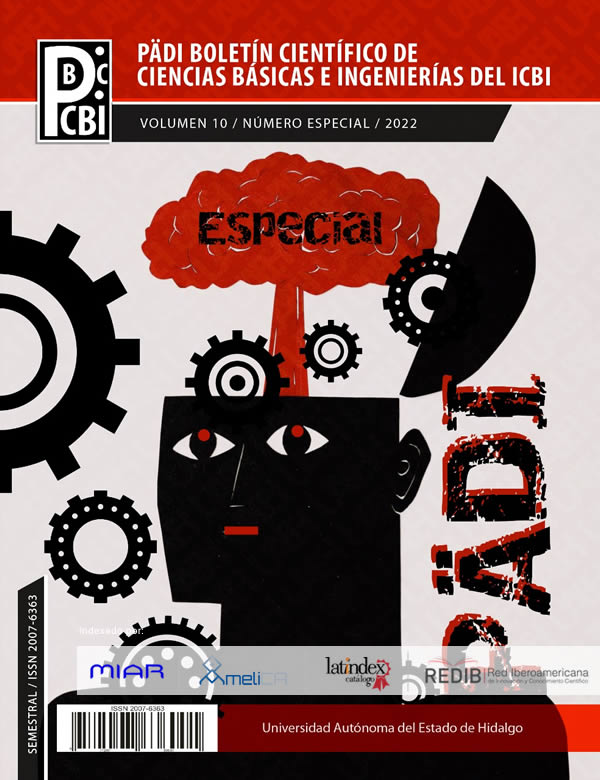Influence of curvature on pattern formation: Turing mechanism in the circle
Abstract
In this work, we study the influence of the curvature of the medium on the formation of patterns through the Turing mechanism of instability guided by diffusion. To analyze the effect of the curvature, we consider the simplest closed curve variety, a circumference. We present the Laplace-Beltrami operator, which is the generalization of the Laplacian on manifolds, to solve the diffusion equation and describe the modifications that the curvature induces on the distribution function and the mean square displacement. As a particular case of study, we use the Gierer-Meinhardt model. It is shown that the range of unstable modes where it will be possible to find the spatio-temporal patterns depends on the radius and, therefore, on the specific circle’s curvature.
Downloads
References
Amazon, J. J., Goh, S. L., and Feigenson, G. W. (2013). Competition between line tension and curvature stabilizes modulated phase patterns on the surface of giant unilamellar vesicles: A simulation study. Phys. Rev. E., 87:022708.
Arfken, G. and Weber, H., editors (2005). Mathematical Methods for Physicists. Elsevier Academic Press.
Ball, P. (2015). Forging patterns and making waves from biology to geology: a commentary on Turing (1952) the chemical basis of morphogenesis. Phil. Trans. R. Soc. B, 370:20140218.
Brigatti, E., N´u˜nez-L´opez, M., and Oliva, M. (2011). Analysis of a spatial Lotka-Volterra model with a finite range predator-prey interaction. Eur. Phys. J. B, 81:321.
Brinkmann, F., Mercker, M., Richter, T., and Marciniak-Czochra, A. (2018). Post-Turing tissue pattern formation: Advent of mechanochemistry. PLOS Computational Biology, 14:e1006259.
Capasso, V. and Wilson, R. (1997). Analysis of a reaction-di usion system modeling man–environment–man epidemics. SIAM J. Appl. Math., 57:327–346.
Castro-Villarreal, P., Villada-Balbuena, A., M´endez-Alcaraz, J. M., Casta˜neda-Priego, R., and Estrada-Jim´enez, S (2014). A brownian dynamics algorithm for colloids in curved manifolds. J. Chem. Phys., 140:214115.
Chac´on-Acosta, G., N´u˜nez-L´opez, M., and Pineda, I. (2020). Turing instability conditions in confined systems with an effective position-dependent diffusion coefficient. J. Chem. Phys., 152.
Chaplain, M., Ganesh, M., and Graham, I. (2001). Spatio-temporal pattern formation on spherical surfaces: numerical simulation and application to solid tumour growth. Journal of Mathematical, 42.
Crank, J. (1980). The Mathematics of Diffusion. Oxford University Press. do Carmo, M., editor (1976). Di erential Geometry of curves and surfaces. Prentice Hall, Inc., New Jersey.
Fuselier, E. and Wright, G. (2013). A high-order kernel method for diffusion and reaction-di usion equations on surfaces. J. Sci. Comput., 56:535.
Fuseya, Y., Katsuno, H., Behnia, K., and Kapitulnik, A. (2021). Nanoscale Turing patterns in a bismuth monolayer. Nat. Phys., 17:1031–1036.
Gatenby, R. A. and Gawlinski, E. (1996). A reaction-diffusion model of cancer invasion. Cancer Research, 56:5745 -5753.
Getzin, S., Yizhaq, H., Bell, B., Erickson, T. E., Postle, A. C., Katra, I., Tzuk, O., Zelnik, Y. R., Wiegand, K., Wiegand, T., and Meron, E. (2016). Discovery of fairy circles in Australia supports self-organization theory. PNAS, 113:3551–3556.
Gierer, A. and Meinhardt, H. (1972). A theory of biological pattern formation. Kybernetik, 12:30–39.
Gjorgjieva, J. and Jacobsen, J. (2007). Turing patterns on growing spheres: the exponential case. DCDS Supplements, 2007(Special):436–445.
Krause, A. L., Burton, A. M., Fadai, N. T., and Gorder, R. A. V. (2018). Emergent structures in reaction-advection-diffusion systems on a sphere. Phys. Rev. E, 97:042215.
Krause, A. L., Ellis, M. A., and Gorder, R. A. V. (2019). Influence of curvature, growth, and anisotropy on the evolution of Turing patterns on growing manifolds. Bull. Math. Biol., 81:759–799.
Le´on-Velasco, D. A. and Chac´on-Acosta, G. (2021). Full finite element scheme for reaction-diffusion systems on embedded curved surfaces in R3. Adv. Math. Phys., page 8898484.
Liaw, S., Yang, C., Liu, R., and Hong, J. (2001). Turing model for the patterns of lady beetles. Phys. Rev. E, 64:041909.
Liu, Y. J., Zhu, L., Wang, A., and Wang, B. (2011). Dynamical behavior of an epidemic model. Braz. J. Phys., 41:304–308.
Mimar, S., Juane, M. M., Park, J., Mu˜nuzuri, A. P., and Ghoshal, G. (2019). Turing patterns mediated by network topology in homogeneous active systems. Phys. Rev. E, 99:062303.
Murray, J. D., editor (2003). Mathematical Biology II: Spatial Models and Biomedical Applications. Third Edition, Springer-Verlag, Berlin Heidelberg.
Nampoothiri, S. (2016). Stability of patterns on thin curved surfaces. Phys. Rev. E, 94:022403.
N´u˜nez-L´opez, M., Chac´on-Acosta, G., and Santiago, J. A. (2017). Diffusiondriven instability on a curved surface: Spherical case revisited. Braz. J Phys, 47:231–238.
Plaza, R., S´anchez-Gardu˜no, F., Padilla, P., Barrio, R., and Maini, P. (2004). The effect of growth and curvature on pattern formation. J. Dyn. Diff. Eqs., 16:1093.
Ramakrishnan, N., Kumar, P. S., and Radhakrishnan, R. (2014). Mesoscale computational studies of membrane bilayer remodeling by curvatureinducing proteins. Phys. Rep., 543:1–60.
Sens, P. and Turner, M. S. (2011). Microphase separation in nonequilibrium biomembranes. Phys. Rev. Lett., 106:238101.
Stoop, N., Lagrange, R., Terwagne, D., Reis, P., and Dunkel, J. (2015). Curvature-induced symmetry breaking determines elastic surface patterns. Nature Materials, 14:337–342.
S´anchez-Gardu˜no, F., Krause, A. L., Castillo, J. A., and Padilla, P. (2019). Turing-Hopf patterns on growing domains: the torus and the sphere. J. Theor. Biol., 481:136–150.
Turing, A. M. (1952). The chemical basis of morphogenesis. Philos. Trans. Roy. Soc., 237:37–72.
Turing, A. M. (1954). Part iii: A solution of the equations morphogenetical for the case of spherical symmetry.
van Meer, G., Voelker, D. R., and Feigenson, G. W. (2008). Membrane lipids: where they are and how they behave. Nat. Rev. Mol. Cell Biol., 9:112–124.
Vandin, G., Marenduzzo, D., Giryachev, A. B., and Orlandini, E. (2016). Correction: Curvature-driven positioning of Turing patterns in phase-separating curved membranes. Soft Matt., 12:3888–3896.
Varea, C., Arag´on, J., and Barrio, R. (1999). Turing patterns on a sphere. Phys. Rev. E, 60:4588.
Webb, G. F. (1981). A reaction-diffusion model for a deterministic diffusive epidemic. J. Math. Anal. Appl., 84:150–161.
Zhu, L., Yuan, H., Wu, K., Wang, X., Liu, G., Sun, J., Liao, X., and Chen, X. (2021). Curvature-controlled delamination patterns of thin films on spherical substrates. iScience, 24:102616.













